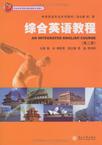体育英语专业系列教材(第二册)
出版时间:1970-1 出版社:北京大学出版社 作者:柳莉蕊 等 著 页数:228
前言
从2002年开始,国内的体育院校纷纷开设了体育英语专业,培养在体育领域从事对外交流工作的国际体育人才。经过五年多的发展,体育英语专业既显示出强大的生机和活力,又面临着诸多困难,首要的问题就是教材问题。目前,体育英语专业大多在技能类课程,特别是基础阶段课程中沿用了全国统编英语专业教材。这些教材选材精当、设计合理,对夯实学生语言基本功起到了巨大作用。但是体育英语专业有其专业的特色,因此,从2004年开始,我们就着手策划编写一套供体育英语专业学生使用的系列教材。并于2007年获得北京市高等教育精品教材立项。此系列教材包括基础阶段的《综合英语教程》、《英语听说教程》、《英语阅读教程》和高级阶段的《体育英语阅读》等,首批推出的是基础阶段的《综合英语教程》和《英语听说教程》。 经教育部批准的《高等学校英语专业英语教学大纲》指出:英语专业学生应具有扎实的语言基本功、宽广的知识面、一定的相关专业知识、较强的能力和较高素质。基础阶段的各教程正是按照这一培养目标编写的,立足于加强学生语言基本功,在培养语言基本功的同时渗透体育元素、人文精神,以提高学生的体育知识水平和人文素养,并在设计中力图培养学生的跨文化交际能力和独立思维能力。同时。本系列教材的一个突出特点是将各门课程的同一单元统一于一个话题,学生在“综合英语”、“英语阅读”、“英语听说”课程中同步围绕一个话题进行不同的技能训练,也使得他们能从不同角度认识同一问题。 《英语听说教程》共4册,本书为第二册,内有12个单元。每单元的主题与《综合英语教程》的主题相同,但内容的取材原则体现不同的重点。每单元分为听说两大模块,听力部分计划用5个学时完成,口语部分计划用两个学时完成。本教程听说一体,学习者在接受了大量的相关话题的信息输入后,可以对此话题进行讨论。 听力材料的选择以短小精悍、难度适中的国外原版材料为主,兼顾材料的多样性、信息性、知识性和趣味性及语言的真实性与实用性,避免枯燥,每次课都有新的内容,有效地避免了各门课程脱节。
内容概要
《综合英语教程(第2册)》是为体育院校英语专业学生编写的综合英语教程。课文内容广泛,涉及政治,历史、伦理、文化、教育、体育、家庭等诸多领域,在培养学生听说读写译各项技能的同时渗透体育元素、人文精神。在学习英语的同时,学生可进一步扩展视野,熟悉体育,提高人文素养。《综合英语教程(第2册)》还适于体育、传媒、翻译等专业的学生及研究生使用。《综合英语教程(第2册)》共12个单元,供体育英语专业一年级第二学期教学使用。按照综合英语课程每学期96个学时的教学时数,每单元需用8个学时完成教学,各校在使用时也可以根据需要进行调整。
书籍目录
Unit 1 FamilyText Ⅰ Kinship and the FamilyText Ⅱ A Father s Walk to SchoolUnit 2 JobsText Ⅰ Why People WorkText Ⅱ Making the Best of a Good JobUnit 3 BusinessText Ⅰ Japanese Style in Decision-MakingText Ⅱ Playing to WinUnit 4 MusicText Ⅰ Music and HealingText Ⅱ Sport and MusicUnit 5 DisastersText Ⅰ We Are the ProblemText Ⅱ After the TornadoUnit 6 Legends and MythsText Ⅰ Modern MythologyText Ⅱ Prometheus Steals Fire——A Myth of Ancient GreeksUnit 7 ShoppingText Ⅰ A Pair of Silk Stockings (Ⅰ)Text Ⅱ A Pair of Silk Stockings (Ⅱ)Unit 8 Women around the WorldText Ⅰ The Feminine MystiqueText Ⅱ StillaPerfect 10Unit 9 TravelText Ⅰ Transformative TravelText Ⅱ Sport and Tourism to Stimulate DevelopmentUnit 10 Famous PeopleText Ⅰ Jefferson TodayText Ⅱ Kings of AthletesUnit 11 HealthText Ⅰ Models of HealthText Ⅱ Ⅰn Sickness, in HealthUnit 12 MemoriesText Ⅰ The 1896 Olympic Games in AthensText Ⅱ Ⅰ RememberReferences
章节摘录
Part of the problem now is that there are billions of us humans. Ascivilization evolved, we moved to where we could live comfortably and wherewe had the resources to meet our needs for food, water, energy, shelter, andtransportation. We settled along coastlines and rivers where water was available,crops would grow, the climate was hospitable, and we could trade goods withother groups of people. We settled near volcanoes where the soil was fertile forcrops. As time went on, we concentrated in groups for defensive reasons; townsgrew larger but essentially in the same locations that were most suitable for ourbasic needs. As our cities grew, our infrastructure became entrenched. Our shelters, ourtransportation systems, and our communication networks became permanent——houses, stores, factories, roads, bridges, dams, water supply systems, and powerlines. When natural events impacted us, we fought back. We built levees to holdback rising rivers, not realizing that with our towns built on floodplains, wewere living in the natural high-water paths of many rivers. We should not havebuilt in these places to begin with, but back then we did not know any better.We should have built our towns on higher terraces above the level of floods. Wecould have still used floodplains to grow crops but abandon them temporarilywhenever the water rose. Unfortunately, that is all in hindsight. Our towns grewup where they did, and we have to live with the consequences.
图书封面
评论、评分、阅读与下载
